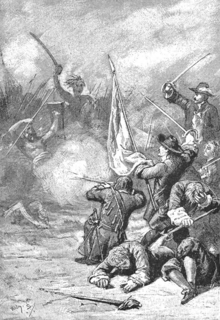
Back تمرد تروناجايا Arabic Révolte de Trunajaya French Pemberontakan Trunajaya ID Rivolta di Trunajaya Italian Trunajaya-opstand Dutch Khởi nghĩa Trunajaya Vietnamese 杜鲁诺佐约起义 Chinese
| Trunajaya rebellion | |||||||
|---|---|---|---|---|---|---|---|
 An 1890 Dutch depiction of fighting between VOC soldiers and Trunajaya's forces during the war | |||||||
| |||||||
| Belligerents | |||||||
|
|
Rebel forces Rival claimants to Mataram throne (after 1677) | ||||||
| Commanders and leaders | |||||||
|
|
Rebel leaders: Co-belligerent (1677–1681): Pangeran Puger | ||||||
| Strength | |||||||
|
|
Trunajaya: Puger: | ||||||
The Trunajaya Rebellion (also spelled Trunojoyo; Indonesian: Pemberontakan Trunajaya) or Trunajaya War was the ultimately unsuccessful rebellion waged by the Madurese prince Trunajaya and fighters from Makassar against the Mataram Sultanate and its Dutch East India Company (VOC) supporters in Java (in modern-day Indonesia) during the 1670s.
The uprising was initially successful; the rebels gained Gegodog (1676), the majority of Java's north coast (1677), and the capital of Mataram (1677) from the royal army. During the retreat of the royal court, King Amangkurat I died. Amangkurat II, his son and successor, asked the VOC for assistance in exchange for cash payments and territorial concessions. The subsequent engagement of the VOC changed the course of the battle. Trunajaya was driven from Surabaya (1677) by VOC and Mataram forces, who also helped him reclaim lost territory and take control of his new capital at Kediri (1678). However, the uprising persisted until Trunajaya was captured at the end of 1679 and the other rebel leaders were overthrown, killed, or submitted (1679–1680). Amangkurat II personally executed Trunajaya in 1680 while he was a prisoner of the VOC.
After his father died in 1677, Amangkurat II also faced rival claims to the throne. The most serious rival was his brother Pangeran Puger, who took the capital Plered in 1677 and did not surrender until 1681.
- ^ a b Andaya 1981, pp. 214–215.
- ^ Ricklefs 1993, p. 50.
- ^ Ricklefs 1993, p. 35.
- ^ a b Ricklefs 1993, p. 51.
- ^ Andaya 1981, p. 218.
- ^ Andaya 1981, p. 221.
- ^ Ricklefs 2008, p. 94.
© MMXXIII Rich X Search. We shall prevail. All rights reserved. Rich X Search